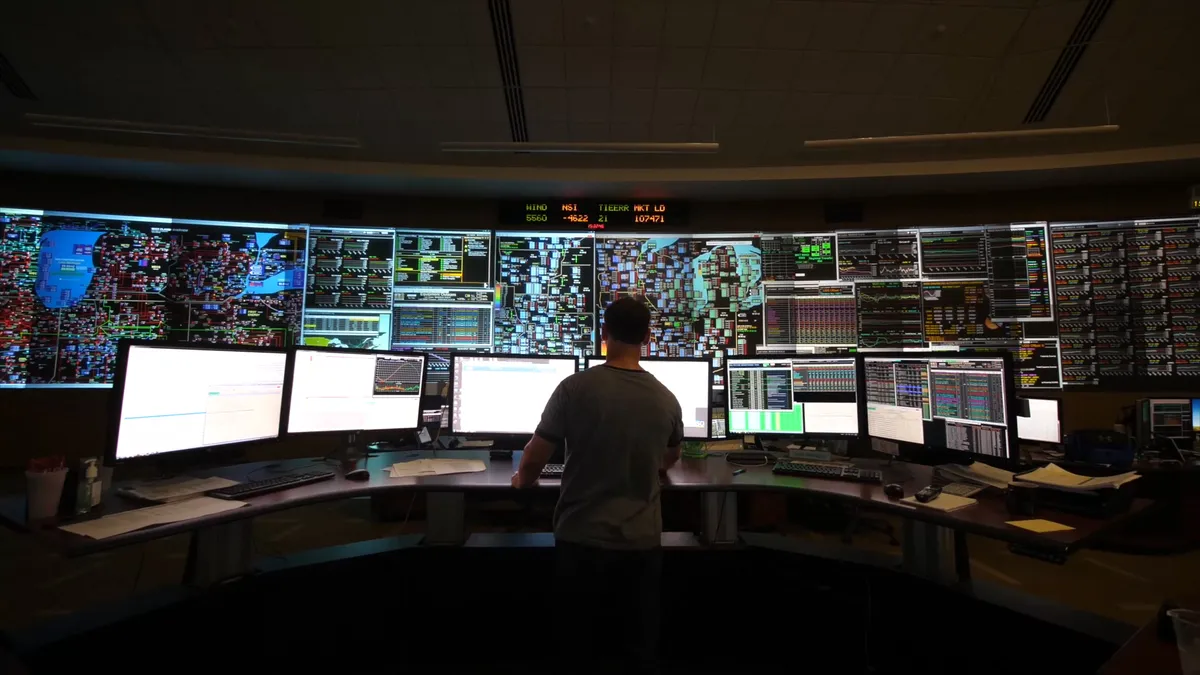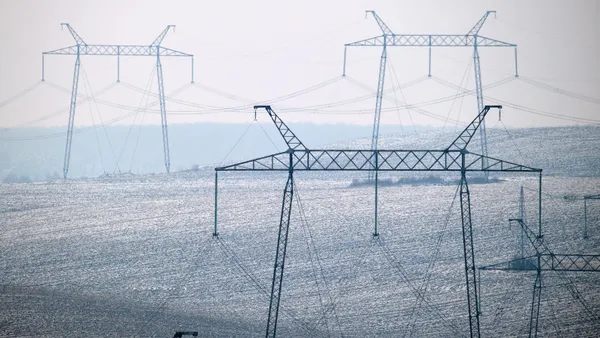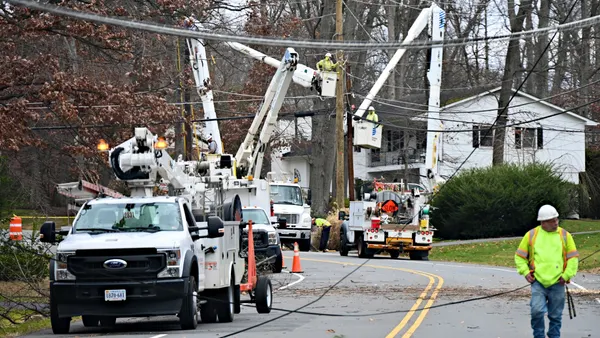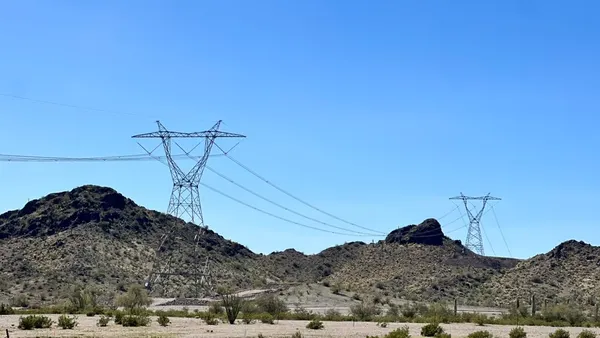Data.
Data, data, data.
It's become a key word in the industry, as more focus is put on efficiency and connected devices. Data is the information floating around that utilities must harness in order to tie together the myriad technologies that have spread across the grid.
And when analyzed in the right ways, that data can help utilities more efficiently maintain their generation and transmission grids, ultimately helping to lower bills for consumers.
The New York Power Authority (NYPA) has developed a state-of-the-art monitoring and diagnostic system that will analyze tens of thousands of data points. Combined with new strategies for analyzing all of that information, and a tight collaboration up and down the supply chain, NYPA is working to be the first "digital utility." And officials say these new approaches will soon become the norm as they are adopted by growing numbers of utilities.
"Data is not information. You have to do something to data to turn it into actionable information."

Rich Gaines
Director, NYPA's Integrated Smart Operations Center
But the process we're talking about doesn't end with the data: that's just the beginning. Data is an abstraction until you can find a way to use it. And therein lies the real value of a digital utility.
"Data is not information. You have to do something to data to turn it into actionable information," said Rich Gaines, director of NYPA's new Integrated Smart Operations Center (ISOC).
Located in NYPA's White Plains, N.Y., offices, the authority describes its new operations center as "a technological revolution." Working with GE, NYPA wants end-to-end visibility, from its 16 power plants and across 1,400 miles of transmission.
That's a lot of data.
Gaines said NYPA runs more than 400 applications, constantly generating and analyzing 24,000 data points from sensors that monitor every step of the production and transmission of electricity. And the center is doing that in real time, "so that you're not relying on a monthly look-back report. You can intervene and make course corrections in real time," he said.
In an effort to make its generation and transmission system as efficient as possible, engineers had to make NYPA's data systems efficient as well. According to Gaines, utilities are only utilizing a very small amount of the data available to them. By some estimates, he said, it is as low as 1% to 5%.
At ISOC, they want to use it all.
If it ain't broke ...
At the heart of ISOC's monitoring and diagnostics is a strategy of "maintenance by exclusion." If equipment is working well, leave it alone. That sounds simple enough, but before there was such detailed and real-time information, generators couldn't really identify small anomalies or losses of efficiency.
Such a strategy is valuable to utilities because both unplanned outages, and unnecessary planned outages, can be costly.
Anomaly detection "allows us to focus our efforts only on the pieces of equipment that are not operating normally," Gaines said. "Everything that is operating normally, we don't have to pay attention to."
Having greater insight into how equipment is working can allow more efficient scheduling of maintenance, and that's what NYPA wants: maintenance schedules that are orderly and planned, because that will result in greater reliability and lower costs.
"Anomaly detection means only working on equipment that is not operating normally," Gaines said. "When one of those data points goes outside what we think is a normal residual tolerance band, we get what's called an 'advisory.'"
NYPA is using what is known as a "digital twin." Running alongside all of the diagnostic data from the actual equipment is an idealized model — what the generator would expect to see under ideal conditions. If those numbers look similar, all is well.
Utility Dive spoke with Navigant Research Analyst Michael Kelly last year about "digital twins," and how they could be combined with artificial intelligence to predict equipment issues and outages.
Essentially, artificial intelligence can help move grid maintenance "from descriptive to predictive," Kelly said, using the same technique of comparing a digital twin with real-time data. "You're going to start seeing more prescriptive analytics," he said, mirroring Gaines's certainty that these ideas for improving reliability will be broadly adopted.
Predicting the failure of equipment can lessen the cost of interruptions and optimize maintenance and upgrade schedules. "We've always had an idea of how to do predictive maintenance, but it is low-level," Kelly said.
Gaines eschews the AI label, saying NYPA's ISOC lacks the neural networking necessary. And despite the automation built into the system, monitoring decisions still rely on human beings at the end of the day.
Human collaboration remains key
This is how the process works: When an advisory is created, an engineer and monitoring specialist determine whether it warrants being made a "case."
"There are many more advisories that come in, than there are cases generated," Gaines said. But once a case is generated, all of that information is then mailed to the asset owner, such as a power plant. NYPA holds a weekly call with the 16 power plants that generate its electricity, and they go through each of the cases with the plant owners.
"Collaboration is very, very important," Gaines said. "Between plant staff and our engineers, between operations and maintenance. The weekly meetings bring people together and turn data into actionable information."
It's important to remember, though, that ISOC doesn't control these plants, and cannot make any adjustments to how they operate. That's the job of plant managers; ISOC's lack of control is an inherent security measure to help guard against any cyber intrusion at the plants.
An attack at ISOC could not impact grid operations
The creation of a digital utility inherently means a lot of connected systems. And cyber threats have become a major issue for the utility industry. So far, there have been no successful attacks against the United States' utility sector, but in 2015, hackers created widespread blackouts in Ukraine. Cybersecurity was already a concern, but the Ukraine attack got the industry's attention.
Every other year, the North American Electric Reliability Corp. runs a simulated attack to boost coordination, and last year Utility Dive's 2017 survey of utility professionals found grid security to be the most pressing issue facing the industry.
But Gaines said NYPA's monitoring equipment cannot be used to attack the grid because it doesn't have any control over the plants — the data is generated by equipment and sent to ISOC for assessment, with no ability for ISOC to make adjustments at a plant.
"We don't call it a control center, because we don't control anything," Gaines said. "We take the data pushed out of those control systems."
"There will be different platforms out there, but I think a lot of utilities will start to look at this concept of maintenance by exception, bad actor identification and marrying cost and efficiency data with anomaly detection, to improve reliability and availability."

Rich Gaines
Director, NYPA's Integrated Smart Operations Center
Distributed control systems and SCADA systems were always isolated by design, Gaines said, not connected to any wider area network. Getting the information out of those silos was a challenge, but inherent to the final product.
"What we mean by 'digital utility' is end to end connectivity," Gaines said.
In its first of operation, NYPA said the monitoring center detected several issues that could have led to equipment failures or potential outages, and saved an estimated $3 million. Gil Quiniones, NYPA’s president and CEO, said the power authority is also implementing digital solutions for improving building energy performance, and "incorporating digitization into our ongoing research efforts aimed at improving the electric grid.”
The key will be "advanced data analysis and other digital strategies to make optimal, cost-efficient asset management decisions while producing low cost and reliable power," Quiniones said in a statement.
An idea expected to catch on
NYPA may say it's the "first fully digital utility," but Gaines said the approach will soon become the norm across the industry as utilities develop their own in-house programs.
"There will be different platforms out there, but I think a lot of utilities will start to look at this concept of maintenance by exception, bad actor identification and marrying cost and efficiency data with anomaly detection, to improve reliability and availability," Gaines said.
The digitalization of the utility sector ultimately aims for lower costs and more consistent reliability. And that can show up in many forms. Other utilities are taking more incremental steps, but are also getting results through high-tech monitoring and evaluation.
Baltimore Gas & Electric recently said that its customers had experienced the highest year of reliability in the company's history in 2016. The company spent about $1.1 billion on infrastructure upgrades in 2017, "exploring innovative technologies that can improve system reliability."
The utility has been using drones to make power line inspections safer and more efficient, and has installed specialized equipment that can automatically restore service or isolate damage.
The utility installed two time-domain protective relays on its transmission system as a pilot project to monitor and analyze transmission line performance. It is a method the utility says is several times faster than traditional phasor-based relay protection.
"This saves lost power and increases safety, improves reliability and improves the lifespan of equipment," BGE spokesman Richard Yost said in an email.
Other monitoring installations include reclosers, which can stop the flow of electricity in the event of a disruption, and "shark fin disconnect switches" to limit the impact of outages by de-energizing when there is line damage.
"The shark fins allow customers on one side of the switch to have their service restored while repairs can be made safely on the other side," Yost explained.
Florida Power & Light has installed flood monitoring equipment in substations, allowing them to be de-energized automatically, to avoid ruining equipment in the event of a storm.
Utilities are bringing to bear a new set of monitoring resources to keep costs low and reliability strong. "These are very expensive assets and they produce a lot of data," Gaines said. "There's no reason we shouldn't be looking at the data to gain insights into the health of the equipment."














